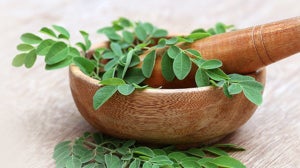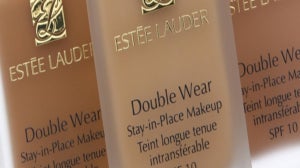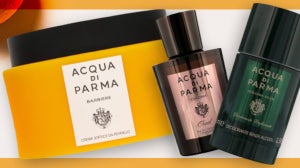
Woody Scents
Perfumers love woody scents because of their versatility. They are usually used as base notes in perfumes to bring depth to and enhance the essence of other scents that make up a fragrance blend. These scents are the ones that linger on your skin once the fragrances of the lighter top and middle notes have died down. Woody scents offer notes that are reminiscent of materials like bark, wood, resin, and even mosses – which make up an entire woody scent subgroup of their own. Woody scents can be dry and crisp like cedarwood, or rich and complex like vetiver.
The outdoorsy impression woody scents can evoke has meant that they are often associated with masculine fragrances, although you’d be hard pressed to find any perfume – masculine or feminine – that does not contain a woody note. These captivating scents are often combined with lighter citrusy or floral notes to add to their allure. You can find woody tones in fragrances for both him and her. Let’s take a look at some of the most popular woody scents.
Cedarwood
For centuries, cedarwood has been revered for its spiritual properties. Tibetans use its oil in incense, while the Cherokee believe that the wood of the cedar trees contains powerful protective spirits. Today, cedar fragrances used in perfumes are usually created in laboratories for environmental reasons, as cedars are slow-growing trees. Typically used as a base note, cedarwood gives perfumes a bright, fresh scent, with deeper hints of resin. Cedarwood combines well with fresh or floral top notes.
Frankincense
One of the first Christmas gifts ever given, frankincense was once worth more than gold! Luckily for perfumers, it’s a little easier to get hold of these days. Frankincense is a versatile ingredient that works as a perfect base note while blending scents. It works well as a fixative for lighter floral notes and leaves a lingering earthy, smoky, yet light scent as the perfume dries down. It’s also used in aromatherapy as an essential oil to restore balance, reduce anxiety and strengthen the immune system. Find your frankincense-based perfume or home fragrance here.
Patchouli
Patchouli is a species of flowering plant native to tropical Asia. Its name literally translates to green leaf’, and it adds a richness to a perfumer’s arsenal of scents. Depending on how mature the leaves are when they are picked, patchouli can smell quite light and fruity, or deep, musky, and earthy, making it an ideal base for woody oriental perfumes. Patchouli oil’s strong, sweet scent makes it a popular choice for aromatherapy and home fragrance products such as scented candles, and it is also used in a variety of skincare products thanks to its anti-inflammatory and moisturising properties.
Vetiver
Although classified as a woody fragrance, vetiver oil actually comes from the roots of a tall tropical grass native to the Indian Subcontinent, although it’s now widely cultivated in regions such as Haiti, Brazil and Indonesia. Vetiver oil is used to stabilize other more volatile ingredients in a fragrance blend, and it is known as the ‘Oil of Tranquillity’.
As a scent itself, vetiver is complex, giving an earthy, woody, leathery, and smoky allure at the same time. Vetiver is primarily used in men’s fragrances, although you won’t be surprised to find some women’s perfumes use it as an enticing base note as well.
Floral Scents
Perfumes with floral scents are among the most popular out there. Floral fragrances, as the name suggests, are scents derived from flowers. They are typically used as top notes in a scent blend to add lightness to heavier base and middle notes. Floral notes are vital to a perfumer’s arsenal of scents as they are often used to give you that all-important first impression of a perfume. With notes ranging from delicate to complex and intense, floral scents are very popular in women’s perfume, but some of the best masculine fragrances carry floral notes too. Fragrances with floral notes are perfect for daywear or outdoor occasions. Here are some of the most popular scents used in floral fragrances.
Lavender
This is one scent that doesn’t need an introduction. One of the most versatile natural products out there, lavender is used in aromatherapy, perfumery, bath products, skincare and more. As an aromatherapy scent, lavender is renowned for its calming properties and helps to reduce stress, anxiety, and even pain. In perfumes, lavender is typically used either as a top or a middle note. Lavender works well with scents like patchouli, bergamot, rosemary, and orange blossom.
Clary Sage
Clary sage is related to the culinary herb sage but is popular in perfumery thanks to its herbaceous sweetness. Clary sage makes an ideal middle note in a perfume, as its fragrance contains deeper tones like amber and balsamic along with lighter lavender tones. Clary sage extracts are used as fixatives in perfumes and blend well with lighter citrus oils and fragrances. Clary sage is also widely used in aromatherapy as a stress reliever and to reduce anxiety. Clary sage essential oil is also often used in labour and birth, as well as being traditionally used to soothe period pain and some symptoms of menopause.
Helichrysum
Also known as Immortelle or Everlasting Flower, Helichrysum italicum is an unassuming little plant with bright yellow flowers, found in Southern Europe. Typically harvested in June, Helichrysum oil is costly to produce, making it one of the most expensive essential oils you’ll find on the European market. Helichrysum acts as an ideal middle note in perfumes, with hints of tea, honey, rose, and chamomile combined with a slight earthiness that works well for both masculine and feminine fragrances. Helichrysum blends well with vetiver, bergamot, citrus oils, and oriental scents.
Tea Tree
The tea tree (Melaleuca alternifolia) finds its origins in Australia, where Aboriginal Australians are believed to have used its leaves in traditional medicine for many years. Using steam, tea tree oil is distilled from the leaves of the tree, before being used in many of your favourite skincare products and fragrances. Tea tree oil is also often used in aromatherapy to promote cleansing and purity. It is also used as a middle note in perfumes and has a scent reminiscent of warm pine and nutmeg. Tea tree works well with lavender, clary sage, oakmoss and geranium.
Oriental Scents
Oriental fragrances are heady scents known for their opulence and spicy aromas. Typically derived from traditionally prized ingredients once traded on ancient spice routes that went from India and Arabia to Europe, these sensual scents add a touch of the exotic. Oriental scents are usually used as base notes in a perfumer’s blend to open up a whole new world of complex, crossover scents that combine spices with woody, floral, or citrus notes. Contrary to popular belief, not all oriental perfumes are heavy, as master perfumers have perfected the art of creating lighter fragrances with an oriental feel. Oriental scents add appeal to perfumes for both him and her. Oriental scents are ideal for the winter months, or for creating an air of sophistication.
Myrrh
Myrrh gets its name from the Hebrew word ‘murr’ which means bitter – but although its name means bitter, myrrh has both bitter and sweet facets to its bouquet. The resin tapped from the True Myrrh tree that grows in Arabia, Somalia, and Ethiopia has a rich, treacly, and fruity scent, while the oil has a warm, earthy liquorice smell. While the exact notes of myrrh can be hard to pin down as everyone perceives them slightly differently, they are sure to add intrigue to any oriental perfume.
Sandalwood
Sandalwood incense has been used for many years as an aid to meditation, to help focus and still the mind. Acting as a bridge between the oriental and woody fragrance families, sandalwood has a woody sweetness and fixative properties which make it a perfect base note to many feminine perfumes. Versatile in nature, sandalwood is complimented well by scents like vanilla, lavender, patchouli, frankincense, jasmine, and cloves. Sandalwood perfumes are ideal for winter wear with their creamy comforting bouquets, although a sandalwood perfume with floral upper notes can create a summery tropical vibe.
Fresh Scents
Fragrances that fall under the fresh family typically include scents with fruity, citrusy, and ‘green’ aromas. Citrusy scents add a lightness to a fragrance composition and give an impression of cleanness. Fruity scents are becoming more popular, with fragrances that integrate the coolness of cucumber or the sweet tartness of berries alongside more traditional ingredients. Scents that remind you of the ocean or a warm breeze would typically fall under the fresh family too, and these scents are found more often in men’s fragrances than women’s perfumes.
Fresh scents are usually used as top notes. Citrusy scents in particular blend well with oriental or heavy floral fragrances to add lightness, or with other fruits to cut through any cloying sweetness. Fresh fragrances are energising scents that are ideal for that post -workout freshness or for a day spent outdoors.
Bergamot
Bergamot is a fragrant, yellow-coloured citrus fruit which is more bitter than a grapefruit, but not as sour as a lemon. Bergamot has a sweet citrusy smell with a mild hint of spice, making it a cheerful top note that ties the other notes in a perfume together perfectly. The citrus scent of bergamot oil is known for being both uplifting and calming, and it is used in aromatherapy to reduce anxiety.
Citronella
Citronella has a woody, lemony aroma that adds an uplifting freshness to any perfume blend. You’ll typically see extracts of citronella listed in the ingredients of a perfume as citronellal, citronellol, and geraniol. Citronella is mild and sweet with floral notes and works well to bring a floral freshness into a fragrance. In aromatherapy, citronella is used to generate an optimistic mindset, while its antifungal properties make it a popular skincare ingredient too.
Eucalyptus
Not just a favourite of koalas, eucalyptus is also loved by perfumers and aromatherapists too. Hailing from Australia, Tasmania, and New Zealand, the leaves of these fast-growing trees yield a minty, woody, citrusy smelling oil that can be a bit overpowering if not used with care. In the hands of a master perfumer, eucalyptus adds a refreshing top note to create a scent blend that is instantly energising. Eucalyptus is also widely used in aromatherapy to treat a variety of respiratory ailments. Eucalyptus pairs well with cedarwood, rose, or rhubarb, and you’ll find eucalyptus in a number of high-end perfumes for both men and women.
Neroli
Neroli is a delicate scent distilled from the flowers of the bitter orange tree. Neroli oil itself has a naturally mild, citrusy aroma with notes of floral honey. As the flowers are steam-distilled, the process results in neroli scented water which is used to add a bouquet to various skincare products. Neroli blends well with citrus oils, musk, patchouli, and floral scents.
Spearmint
Spearmint oil comes from Mentha spicata, one of the many species of the mint plant. Typically used as a top note, spearmint adds an instantly cooling effect to any skin spray. While it does smell minty, it also adds a hint of sweetness to a fragrance blend. Spearmint blends well with natural floral scents like jasmine, lavender, and rosemary. You can find spearmint in a range of perfumes for him and her.
Once, you’ve found the scents you like, why not use the allbeauty Fragrance Finder to discover your new signature scent?
You can also read the allbeauty guide to wearing perfume, to find out where to spritz – and why.

Related Articles








